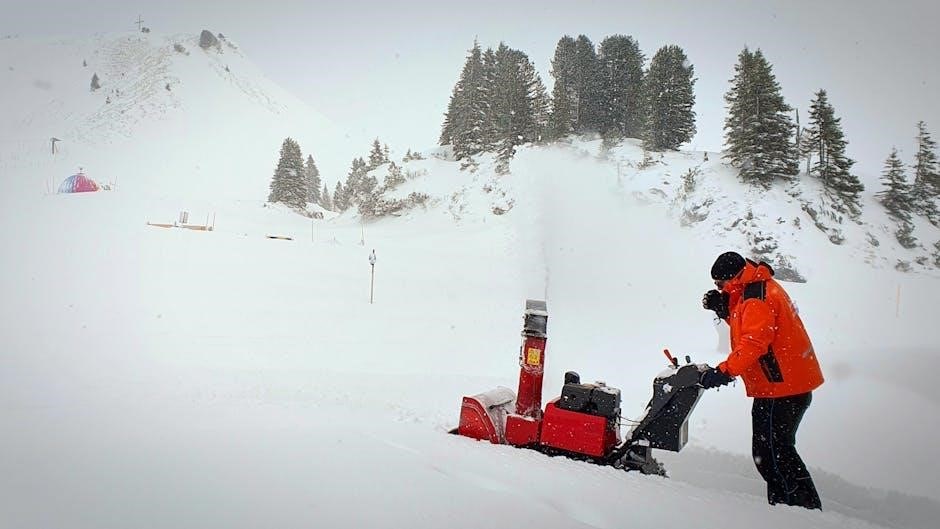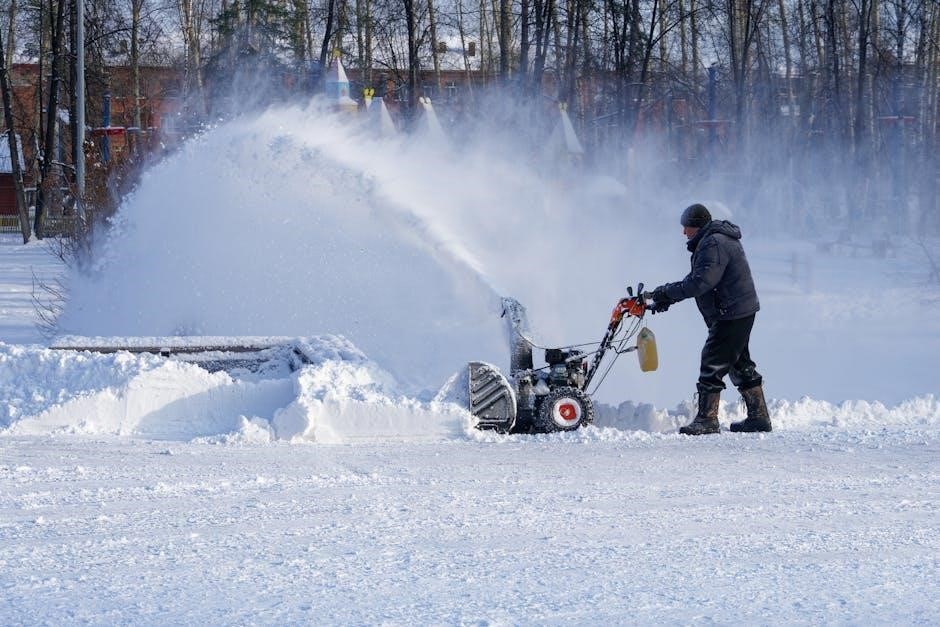troy bilt snowblower manual
Welcome to the Troy-Bilt Snowblower Manual! This guide provides essential information for safe and effective operation, maintenance, and troubleshooting of your snowblower. Read thoroughly to ensure optimal performance.
Designed to help you master your Troy-Bilt snowblower, this manual covers setup, usage, and care. Follow the instructions carefully to maximize efficiency and prolong the life of your equipment.
1.1 Importance of the Manual
The Troy-Bilt Snowblower Manual is an essential resource for understanding your equipment. It provides critical safety guidelines, operating instructions, and maintenance tips to ensure safe and effective use. Reading this manual helps you familiarize yourself with the snowblower’s features, proper handling, and troubleshooting techniques. It also highlights warranty details and environmental considerations, making it a comprehensive guide for maximizing performance and longevity. By following the manual, you can operate your snowblower confidently and efficiently, while minimizing risks and maintaining its optimal condition throughout the winter season.
1.2 What to Expect in the Manual
This manual is a comprehensive guide to your Troy-Bilt snowblower, offering detailed instructions for safe operation, maintenance, and troubleshooting. You’ll find step-by-step assembly guides, routine maintenance schedules, and tips for winterizing your equipment. It also covers safety precautions, diagnostic techniques, and solutions for common issues. Additionally, the manual provides information on genuine parts, warranty details, and environmental considerations. With clear instructions and helpful diagrams, this resource ensures you’re equipped to handle every aspect of your snowblower, from initial setup to long-term care.

Safety Precautions and Warnings
Always follow safety guidelines to operate your Troy-Bilt snowblower safely. Adhere to warnings, wear protective gear, and be aware of potential hazards. Read the manual carefully before use.
2.1 General Safety Tips
Always read and understand the manual before operating your Troy-Bilt snowblower. Wear protective gear, including gloves and safety glasses. Ensure the area is clear of obstacles and people. Keep children away while operating. Never use the snowblower in enclosed spaces or near open flames. Operate only in well-lit areas with good visibility. Avoid wearing loose clothing that could get caught in moving parts. Ensure the snowblower is properly maintained, and follow all manufacturer guidelines for safe operation.
2.2 Specific Safety Warnings
Never operate the snowblower near open flames, sparks, or in enclosed spaces due to the risk of carbon monoxide buildup. Avoid using it in wet or icy conditions to prevent slipping. Do not touch hot engine parts or moving components while the machine is in use. Keep loose clothing tied back to avoid entanglement. Always ensure the model plate information is recorded for reference. Follow all specific warnings in the manual to ensure safe operation and avoid potential hazards. Adhere strictly to the manufacturer’s guidelines for optimal safety.

Identifying Your Snowblower Model
Locate the model plate on your Troy-Bilt snowblower, typically found on the engine or rear. Record the model number and serial number for reference, as these details are essential for maintenance, troubleshooting, and ordering genuine parts. This information ensures accurate support and proper operation of your equipment throughout its lifespan.
3.1 Locating the Model Plate
To identify your Troy-Bilt snowblower model, locate the model plate, typically found on the engine or rear panel. This plate displays the model number and serial number, essential for maintenance and parts ordering. Record these details and keep them with your manual for quick reference. Ensure accuracy, as incorrect information may lead to improper repairs or incompatible parts. Always verify the model plate before contacting support or purchasing accessories. This step guarantees you receive the correct guidance and components for your specific snowblower, ensuring optimal performance and safety.
3.2 Understanding Model Numbers
Your Troy-Bilt snowblower’s model number is a unique identifier that provides essential details about the unit. Typically, the model number is a combination of numbers and letters, where each part signifies specific features, such as engine size, series, or special configurations. For example, a model number like “31AS6BN2711” encodes information about the snowblower’s capabilities and specifications. This information is crucial for ordering parts, troubleshooting, and ensuring compatibility with accessories. Always reference your model number when consulting the manual or contacting support to guarantee accurate assistance and parts ordering.

Assembly and Initial Setup
Unpack and inventory all parts carefully. Follow the step-by-step assembly guide in the manual. Ensure all bolts are tightened to specified torque. Test the snowblower after setup.
4.1 Unpacking and Inventory
Begin by carefully unpacking your Troy-Bilt snowblower from its shipping box. Ensure all components, such as the auger, chute, and control panel, are included. Use the provided inventory list to verify each part. Check for any visible damage or missing items. Refer to the manual for detailed descriptions of each component. Organize the parts in a clean, dry workspace. Take your time to ensure everything is accounted for before proceeding with assembly. Missing or damaged parts should be reported immediately to Troy-Bilt customer support.
4.2 Step-by-Step Assembly Guide
Begin by gathering all tools and hardware provided in the box. Refer to the manual for specific instructions tailored to your model. Start by attaching the handles to the mainframe using the provided bolts. Next, secure the chute and auger assembly, ensuring proper alignment. Tighten all connections firmly but avoid over-tightening. Attach the control panel and connect any wires or cables as indicated. Finally, inspect all parts to ensure they are securely fastened. Double-check your work before moving on to operation. Proper assembly is crucial for safe and effective performance.

Operating Your Troy-Bilt Snowblower
Proper operation begins with preparation. Start the engine, engage the auger, and adjust chute direction as needed. Use controls to manage speed and snow flow safely.
5.1 Starting the Engine
Starting your Troy-Bilt snowblower safely and correctly ensures optimal performance. Always refer to your specific model’s manual for exact instructions. Begin by ensuring the area is clear of debris. Check the choke and throttle positions, then prime the engine as recommended. Pull the starter cord firmly until the engine roars to life. Allow it to warm up briefly before engaging the auger. Never operate the snowblower in an enclosed space due to carbon monoxide risks. Always wear safety gear and keep loose clothing tied back.
- Ensure the choke is in the correct position for a cold start.
- Prime the engine 2-3 times if equipped with a primer bulb.
- Pull the starter cord with a smooth, steady motion.
- Adjust the choke to “run” position once the engine is running.
For electric-start models, turn the key or press the button after priming. Always follow safety guidelines to avoid accidents.
5.2 Basic Operating Techniques
Mastering basic operating techniques ensures efficient and safe snowblower use. Start by adjusting your walking speed according to snow depth and type. For heavier snow, slow down to maintain control and prevent stalling. Keep the snowblower at a steady angle to avoid uneven clearing. Always maintain a firm grip on the handles and avoid sudden movements, which can cause loss of control. For optimal results, overlap your passes slightly to ensure complete coverage.
- Keep the chute directed away from people and windows.
- Clear snow in consistent, overlapping passes for even results.
- Adjust the chute angle as needed for wind direction.
For heavy, wet snow, clear smaller sections at a slower pace. For light, powdery snow, increase your speed for efficiency. Always keep children and pets at a safe distance while operating.
5.3 Using Controls and Features
Familiarize yourself with your Troy-Bilt snowblower’s controls for optimal performance. The chute control allows you to adjust the snow discharge direction, while the deflector adjusts the angle. Use the handle-mounted controls to rotate the chute and change the deflector angle without stopping. The variable-speed control enables you to match your walking pace to snow conditions. For better visibility, use the built-in headlight in low-light conditions. Always keep hands away from moving parts and avoid overreaching. Adjust settings like auger speed and chute direction to suit different snow types and depths for efficient clearing.
- Use the chute control to direct snow where needed.
- Adjust the deflector for precise snow placement.
- Engage the headlight for improved visibility.

Maintenance and Upkeep
Regular maintenance ensures optimal performance. Check and lubricate moving parts, inspect belts, and winterize the snowblower. Follow the recommended schedule for best results.
6.1 Routine Maintenance Schedule
Regular maintenance is crucial for optimal performance. Inspect belts, auger, and chute for wear. Check engine oil and spark plug. Lubricate moving parts seasonally. Winterize by draining fuel and storing properly. Create a schedule based on usage and climatic conditions. Refer to the manual for specific intervals. Ensure all parts are in good condition before each use. Proper upkeep prevents breakdowns and ensures safety. Follow these steps to maintain your Troy-Bilt snowblower efficiently throughout the winter season.
6.2 Winterizing Your Snowblower
Winterizing your Troy-Bilt snowblower ensures it remains in top condition for next season. Drain fuel and add a fuel stabilizer to prevent degradation. Check belts, auger, and chute for wear. Lubricate cables and moving parts. Store the snowblower in a dry, protected area. Inspect and replace any damaged components. Clean the machine thoroughly to remove dirt and debris. Proper winterization extends the lifespan and maintains performance. Always refer to the manual for specific winter care instructions tailored to your model.

Troubleshooting Common Issues
Identify and address common snowblower problems like poor engine performance, jammed augers, or uneven snow dispersion. Check for blockages, worn belts, or clogged chutes.
7.1 Diagnostic Techniques
Start by identifying symptoms, such as poor engine performance or jammed augers. Inspect for blockages in the chute or auger. Check belts for wear or damage. Monitor engine performance, ensuring proper fuel levels and air filter cleanliness. Look for uneven snow dispersion or strange noises. Refer to the manual for specific diagnostic steps tailored to your model. Always prioritize safety during inspections. If issues persist, consult Troy-Bilt support or authorized service centers for professional assistance. Document findings for future reference and maintenance planning.
7.2 Solutions for Common Problems
For a non-starting engine, check fuel levels and ensure the spark plug is clean. If the auger stops, clear blockages and ensure belts are secure. Address uneven snow dispersion by adjusting the chute angle. Lubricate moving parts to prevent friction. Replace worn belts or damaged auger parts. For persistent issues, consult the manual or contact Troy-Bilt support. Always use genuine parts for repairs. Regular maintenance can prevent many common problems. Keep the snowblower clean and store it properly after winter to ensure optimal performance next season.
Replacement Parts and Accessories
Replace worn or damaged parts with genuine Troy-Bilt accessories for optimal performance. Common replacements include belts, auger kits, and skid shoes. Visit authorized dealers or the official website for authentic parts.
8.1 Genuine vs. Aftermarket Parts
When replacing parts for your Troy-Bilt snowblower, choosing genuine parts ensures optimal performance and durability. Genuine parts are designed to fit perfectly and meet safety standards, while aftermarket alternatives may compromise quality and void warranties. Always verify authenticity to maintain reliability and warranty coverage. Troy-Bilt genuine parts are engineered for your specific model, ensuring peak efficiency and longevity. Prioritize safety and performance by selecting authentic components from authorized dealers or the official Troy-Bilt website.
8.2 Where to Find Replacement Parts
Replacement parts for your Troy-Bilt snowblower can be found through authorized dealers, the official Troy-Bilt website, or retailers like Sears Parts Direct. Use your model number to ensure accuracy. Genuine parts are available online or in-store, while aftermarket options exist but may lack warranty support. Always verify the seller’s authenticity to avoid counterfeit products. For convenience, Troy-Bilt’s official website offers a parts lookup tool, ensuring compatibility and quality.

Warranty Information
Your Troy-Bilt snowblower is backed by a comprehensive warranty covering parts and labor for a specified period. Proper registration and maintenance are required for coverage eligibility.
9.1 Understanding Your Warranty
Your Troy-Bilt snowblower is protected by a comprehensive warranty designed to safeguard your investment. The warranty typically covers defects in materials and workmanship for a specified period, ensuring reliable performance. It is essential to review the terms and conditions to understand what is included and any limitations. Proper registration and adherence to maintenance schedules are often required to maintain warranty validity. Refer to your manual or contact Troy-Bilt support for detailed warranty specifics tailored to your model number.
9.2 Filing a Warranty Claim
To file a warranty claim for your Troy-Bilt snowblower, ensure you have your model number and proof of purchase ready. Contact Troy-Bilt customer support through their official website or phone. Provide detailed information about the issue and any supporting documentation. Follow the instructions provided by the support team to initiate the claim process. Once submitted, allow time for review and approval. Keep all records for future reference. Proper documentation and adherence to warranty guidelines ensure a smooth resolution.
Environmental Considerations
This section highlights eco-friendly operation and proper disposal of waste. Using genuine Troy-Bilt parts ensures durability and reduces environmental impact. Embrace responsible practices for sustainable snowblower use.
10.1 Eco-Friendly Operation
Eco-friendly operation involves using your Troy-Bilt snowblower responsibly. Ensure proper maintenance to optimize fuel efficiency and reduce emissions. Use genuine parts to maintain performance and longevity. Regularly check and replace air filters to improve engine efficiency. Operate the snowblower only when necessary to minimize energy consumption. Follow the recommended oil and fuel guidelines to prevent waste. Dispose of used fluids and filters responsibly. By adhering to these practices, you contribute to a more sustainable environment while ensuring your snowblower operates effectively.
10.2 Proper Disposal of Waste
Proper disposal of waste from your Troy-Bilt snowblower is crucial for environmental protection. Dispose of used oil, fuel, and filters responsibly by taking them to recycling centers. Battery disposal must follow local regulations to prevent contamination. Non-hazardous parts can be recycled or disposed of through authorized facilities. Always check local guidelines for specific requirements. Troy-Bilt encourages sustainable practices to minimize environmental impact. By adhering to these disposal methods, you help protect the environment and ensure compliance with waste management laws.

Customer Support and Resources
Troy-Bilt offers comprehensive customer support, including online resources, parts lookup, and service center locations. Visit their official website or contact support for assistance with your snowblower needs.
11.1 Contacting Troy-Bilt Support
Troy-Bilt provides dedicated customer support to address your queries and concerns. Visit their official website to access the “Contact Us” section, where you can find phone numbers, email options, and live chat support. For immediate assistance, call their customer service team, available to help with troubleshooting, repair questions, or parts inquiries. Ensure you have your snowblower’s model number ready for efficient support. Troy-Bilt’s team is committed to resolving issues promptly, whether you need guidance on operation, maintenance, or warranty claims. Their expertise ensures your snowblower runs smoothly throughout the winter season.
11.2 Online Resources and Communities
Troy-Bilt offers a wealth of online resources to support your snowblower experience. Visit their official website for downloadable manuals, parts diagrams, and troubleshooting guides; Join forums and social media communities dedicated to Troy-Bilt users, where you can share tips, ask questions, and learn from others. Additionally, online marketplaces like Sears Parts Direct provide access to genuine parts and accessories. These resources empower you to maintain, repair, and optimize your snowblower with confidence, ensuring it performs at its best throughout the winter season.

Parts Diagrams
Parts diagrams are essential for identifying and ordering genuine Troy-Bilt components. They provide visual representation of your snowblower’s structure, aiding in repairs and maintenance with precision.
12.1 Understanding Parts Diagrams
Parts diagrams are essential tools for identifying components of your Troy-Bilt snowblower. They provide a visual representation of the machine, highlighting individual parts and their locations. By referencing these diagrams, you can accurately identify components for maintenance, repairs, or replacements. Ensure to cross-reference with your model number for precision. These diagrams are available in the manual or online, offering a clear guide to understanding your snowblower’s structure and ensuring proper assembly or repair procedures.
